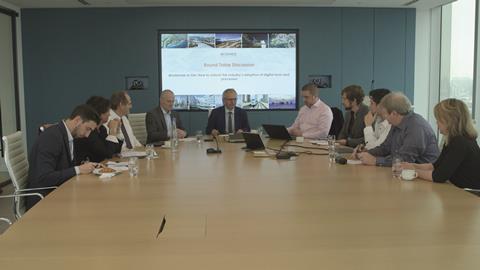A recent report by the Global Industry Council has identified a number of challenges to the adoption of new technologies in the construction industry. Building and construction software expert Aconex gathered representatives from across the sector to discuss first-hand experience of these issues and how they are best overcome.

Digitalisation is disrupting industries across the global economy. However, while some parts of engineering and construction have embraced digital working with gusto, the industry as a whole is often characterised as behind the curve. In the UK, implementation of BIM (building information modelling) remains patchy despite a government mandate that must be used for public projects, and the PAS1192 standard that applies to the whole construction sector.
To get a better understanding of how the sector’s leading global organisations are getting to grips with the challenge of digitalisation, the Global Industry Council (GIC) was set up by Aconex, bringing together senior executives from multinational companies such as Aecom, Bechtel, Fluor and Lendlease.
In a new report (see box), this group identified a number of challenges to the adoption of new technology as well as solutions. To explore how these findings apply to the UK context, Building brought together a number of the industry’s leading digital champions for a roundtable debate that was held in association with specialist construction software provider Aconex.
“We are all busy delivering work and it’s tough. it’s one thing being asked to embrace this, another applying it”
Malcolm Stagg, Skanska
The right ecosystem
The GIC’s emphasis on the need to create a digital ecosystem that makes sense for employees was highlighted by Ivor Barbrook, head of planning and digital construction at contractor Bam Nuttall.
“The real block is cultural challenge: bringing people along with an understanding of why we need to make change and how it will benefit them,” he said.
Neil Thompson of Atkins, said that digitalisation lowered the barriers to entry in built environment industries, like other sectors of the economy.
But greater use of digital tools could help the industry to overcome its skills shortages, he said: “There’s a massive demand for good quality infrastructure and there isn’t enough expertise to deliver it.”
Peter Trebilcock, head of architecture at consultant Capita said that his firm’s staff were switched onto digital ways of working.
“Our staff use lot of digital tools in their work, analysis and design: they get what BIM brings in terms of integrated and cross-disciplinary working and the efficiencies and improvements that can bring.”
Looking to the other end of the process, the end user, he added that companies are also starting to exploit the technology as a sales tool, giving as an example how housing developers are using online models to enable customers to personalise their homes.
But Malcolm Stagg, director of BIM and digital engineering at contractor Skanska, said that the project-based nature of construction impeded efforts to create a digital-friendly ecosystem across the industry.
Teams usually come together for construction projects and then break up, reassembling with different sets of partners, which often involve entirely new permutations of systems.
The fragmented nature of the industry’s supply chain does not help, he added. “We have 20,000 people in our supply chain in the UK: that is the dominant population on our sites.”
There are substantial benefits to be gained if adoption is achieved throughout the supply chain. However, the sharing of digital models would certainly bring benefits across the supply chain, said Trebilcock: “The more parties involved in a project who are digitally literate, the better the outcomes are likely to be.”
On a recent visit to construction projects in the US, Trebilcock said he had seen widespread adoption of BIM. “Every single one was BIM: they demanded it because they wanted more efficient projects. It was the industry norm and expected good practice.”
But making the case for digitalisation can be more problematic back in the UK, he acknowledged: “The challenge is to encourage the supply chain to get digital.”
GIC report: Five key challenges to digitalisation
1.Ecosystem and integration
Complex ecosystem with dispersed data collection and multiple platforms. Organizations struggle to consolidate fragmented platforms, standardize processes and develop digital-savvy talent. Data is generated in dispersed platforms, increasing the risks associated with system interdependencies and integration. However, disconnected processes and disparate systems increase resource and labour requirements in an industry where diminishing returns are at stake.
2. Rationalisation and standardisation
Complex and non-standard processes across projects. Over time, many organizations will procure software and platforms for business operations in the office or field. Others will adopt legacy systems through acquisitions and mergers or business transformation programs. rationalising this plethora of systems will be critical to long term success by eliminating unnecessary layers that absorb valuable resources and time.
3. Digital talent
Not only experts but also digital “savviness” across the workforce. There is a limited pipeline of digital talent due to the pace of emerging trends, traditional training and education for current disciplines, and a highly competitive marketplace. Critical to the successful execution of a digital strategy is ensuring the right level of digital talent, which includes those who can adapt to technological changes in the environment, are able to lead or support transformation and possess the foresight to explore and invest in new developments. However, the GIC believes there is no need to hit the panic button yet.
4. Digital adoption
Apprehension by workforce due to culture and technical challenges. According to Roger’s basic innovation adoption and diffusion model, it takes time to influence users to adopt and embrace change. Often, when a new system is implemented, there is a culture of customization, that is, people trying to make the old way fit the new platform. Support and encouragement from management will be core to driving change within an organization.
5.Visibility of return on investment
Difficult to communicate benefits from large digital investments. In many organisations, there is a lack of executive sponsorship to support digital investment as it is viewed as a cost rather than a potential to save.
Barriers
Matt Olsen, BIM architectural lead at architectural practice Allies and Morrison, pointed to the financial implications of using digital technologies, and said that in the long run, digital transformation paid back in terms of return on investment, one of the five challenges to digital transformation identified by the GIC.
“The added cost needs to be recognised in the light of the value that will be gained further down the stream.”
Olsen said he understood why some firms in the supply chain will be reluctant to embrace the upfront costs of technological solutions. “People are starting to see benefits of BIM working but it’s less apparent across the supply chain.
“We are a large practice and can afford the overheads: we have one person dedicated to this task internally but if you have a small practice and a smaller client, it’s seen that there’s not the money even if you develop the value later.”
Stagg said time pressures were an important barrier to adoption of digital models. “We are all busy delivering work and it’s tough. It’s one thing being asked to embrace this, another applying it.”
And it was often difficult to show return on investment on digital spending within the annual business cycle timeframes that construction firms work to, he added: “It can take more than 12 months to realise returns. We need to start extending out that return period otherwise we will end up failing.
“Without that I struggle to understand how we will develop a return on investment,”
And there is only so much that even a big prime contractor can do to encourage the uptake of digitalisation across its supply chain, said Stagg: “We could work 24/7 with our supply chain, but it’s never enough.”
As a contrast, he pointed to the more systematic way that the automotive industry works with its supply chain.
The GIC’s recommendation on the importance of greater standardisation was highlighted by Lucy Abbott, BIM director at contractor Wates Group, as a way of bringing digital laggards in the supply chain up to speed.
“The catalyst for change will be around a standardised approach. If we have a situation where we have defined standards, we will upskill the supply chain so there is a consistent approach to interpreting and developing information.”
“We have a lot of interest and staff commitment to bim. the challenge is now to bring clients with us to see the benefits for their projects in terms of reducing risk”
Jo Bacon, Allies and Morrison
Clients
It’s not just the supply chain that needs to be convinced about the virtues of digital working, though, but clients too.
Jo Bacon, a director at architect Allies and Morrison, said : “We have a lot of interest and staff commitment to BIM and lots of internal rewards: the challenge is now to bring clients with us to see the benefits for their projects in terms of reducing risk.”
An example is the nuclear industry, which has been slow to adopt digital ways of working, said Trebilcock: “They love paper because they are conservative and they don’t have to worry about cyber security or what format they will have to open it up in five or 200 years’ time.”
And this reluctance extended to the more sophisticated version of BIM, which allow lifetime costs to be modelled, said Trebilcock: “Very few customers ask for Level 2: a number of customers are interested but it is very much up to us to exploit the technology.”
Such clients remained the “exception” rather than the norm, he added: “Unless the customer is engaged in the process and want to leverage benefits it’s left to the design team to be as ambitious or modest as they want.”
But clients are potentially missing out because digitalisation would enable them to better specify outcomes from projects, said Stagg: “Clients have to understand more about this because they’re the ultimate beneficiary.”
Leadership within firms can go a long way to bringing the industry up to speed, said Olsen, pointing to how the buy-in shown by Allies and Morrison’s senior management from 2010 onwards had played a “really critical” role in encouraging adoption of digital technology across the practice.
“We’ve seen the benefits of having BIM-savvy staff moving into project lead level in terms of being aware of BIM,” he said.
All levels of the workforce needed to be engaged in digital ways of working, said Stagg: “It doesn’t work to have a small BIM team at the top that dictates progress, digital adaptation needs to be at all levels. You need to have a workforce that feels empowered to spend part of the week pushing these new processes.”
“The transformation that needs to happen is like health and safety. There will be someone with overall responsibility for health and safety but everyone has a role to play in us being healthy and safe. That has to happen with digitalisation: you may have a digital lead on a project but everyone has to realise they have a role to play.”
In a nod to Roger’s model of how innovation diffusion model (see box, above), Bam’s Barbrook said the human barriers to digital working meant that its roll-out would lag behind that of the technology. “The technology will be there by 2020 but getting people to use that technology will take another five years.”
But ultimately, he said that the industry needed to go digital to achieve a leaner and more efficient business model.
“As tier 1 contractors, we are not looking for employers to tell us to do BIM, we are doing it for our own benefit: this is about how we use technologies and make our business process lean.
“Even if a party is not willing to engage we still have to move down this line because the whole UK industry is going down this lean process. Unless we engage we won’t survive as a business.”
“Very few customers ask for level 2: a number of customers are interested but it is very much up to us to exploit the technology”
Peter Trebilcock, Capita
Roundtable guests
Chair:David Blackman, Building
Lucy Abbott, BIM director, Wates
Jo Bacon, partner, Allies and Morrison
Ivor Barbrook, head of planning, head of digital construction, Bam Nuttall
Steve Cooper, general manager UK and Ireland, Aconex
Nick Leach, strategic BIM manager, Sir Robert McAlpine
Matt Olsen, BIM lead, Allies and Morrison
Malcolm Stagg, director of BIM and digital engineering, Skanska
Neil Thompson, digital transformation – infrastructure, Atkins
Peter Trebilcock, head of architecture, Capita































